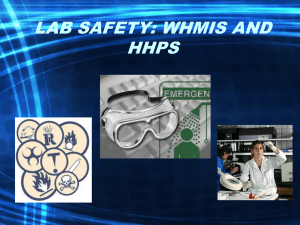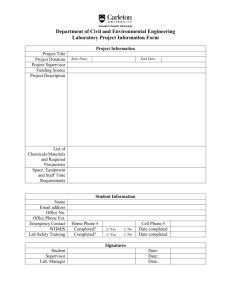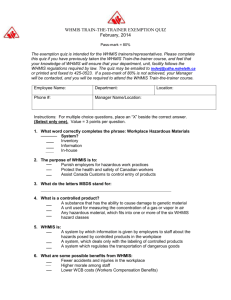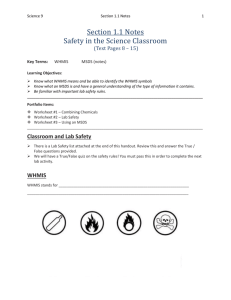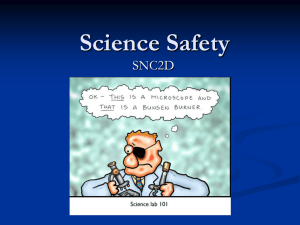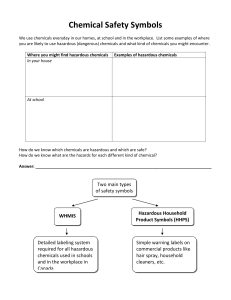File
advertisement
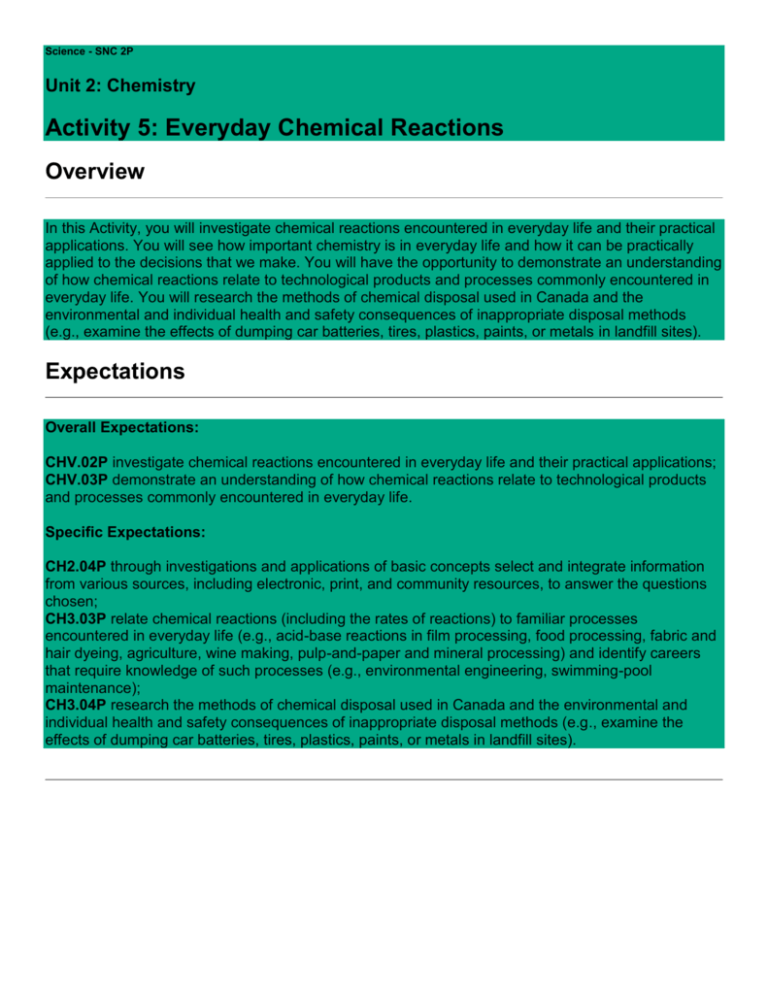
Science - SNC 2P Unit 2: Chemistry Activity 5: Everyday Chemical Reactions Overview In this Activity, you will investigate chemical reactions encountered in everyday life and their practical applications. You will see how important chemistry is in everyday life and how it can be practically applied to the decisions that we make. You will have the opportunity to demonstrate an understanding of how chemical reactions relate to technological products and processes commonly encountered in everyday life. You will research the methods of chemical disposal used in Canada and the environmental and individual health and safety consequences of inappropriate disposal methods (e.g., examine the effects of dumping car batteries, tires, plastics, paints, or metals in landfill sites). Expectations Overall Expectations: CHV.02P investigate chemical reactions encountered in everyday life and their practical applications; CHV.03P demonstrate an understanding of how chemical reactions relate to technological products and processes commonly encountered in everyday life. Specific Expectations: CH2.04P through investigations and applications of basic concepts select and integrate information from various sources, including electronic, print, and community resources, to answer the questions chosen; CH3.03P relate chemical reactions (including the rates of reactions) to familiar processes encountered in everyday life (e.g., acid-base reactions in film processing, food processing, fabric and hair dyeing, agriculture, wine making, pulp-and-paper and mineral processing) and identify careers that require knowledge of such processes (e.g., environmental engineering, swimming-pool maintenance); CH3.04P research the methods of chemical disposal used in Canada and the environmental and individual health and safety consequences of inappropriate disposal methods (e.g., examine the effects of dumping car batteries, tires, plastics, paints, or metals in landfill sites). Content Many things that we use every day are the result of chemical reactions. The chemical industry has grown as a result, and created millions of jobs and much economic growth. However, the industry has also caused much damage to the environment. 55% of electricity is generated by burning coal. This is one of the most polluting industries on Earth. The most common way to remove gold from ore is the use of cyanide. The cyanide then enters the water table around the mine and causes major ecological damage. Chemicals, even when handled properly, can still spill as a result of accidents.; We need to be aware of what we are using, and how those decisions affect those around us. As Catholics, we must always try to see beyond the narrow world we know, and consider the global implications of what we do. What will happen to the computer you are using right this second, when you decide to upgrade to a newer one, with more fancy options? Did you know that many electronics eventually end up in dumps in developing countries, where the chemicals they contain cause cancer among the poor who scavenge them for parts? Many electronics are “disposable”. That is, they cost so much to repair that it is cheaper and easier to buy new ones. Think about that the next time you make a purchase. Think about it the next time you throw something out. Many household products are safe, but others can react violently and dangerously when used (or mixed with others). Take a look in your cleaning cupboard and look at the labels. You will see a variety of symbols that indicate the level of hazard that each substance poses. Read the label of the toilet bowl cleaner. Many of them (not all, but many) specify that they are not to be mixed with other cleaners. That is because they often contain other more reactive chemicals, like bleach. If bleach is mixed with vinegar (an ingredient of many window cleaners and tile cleaners), chlorine gas is produced. That can kill you, and kill you quickly! So follow the instructions! Oven cleaners are strong bases, and are corrosive if gotten on the skin. They often produce strong, caustic fumes as well, and you are instructed to use them in well-ventilated areas to prevent harm. Sometimes we choose cleaners because they react with other substances. Some chemicals dissolve grease. Others can dissolve rust and mineral deposits. Products in the home vary with regards to the risks they pose. The following is a list of the more common symbols you find on household products: This symbol means that a product can explode. Do you have any cans of air freshener in your house? If so, you will most likely find this symbol. It can be inside a red octagon, indicating the highest level of danger, an orange diamond, indicating a moderate level of danger (warning) or a yellow inverted triangle, indicating caution. This symbol warns us that the product is flammable. Do you have any hair spray? Look for this symbol on the label. The level of risk is also indicated by the shape and colour of the symbol border, like the symbol above. Again, this image can be found inside a red octagon, indicating the highest level of danger, an orange diamond, indicating a moderate level of danger (warning) or a yellow inverted triangle, indicating caution. It warns of poisonous effects. Take a look underneath the kitchen or bathroom sink. You may find a few cleaners with this label. Sometimes this symbol is used, and sometimes a skeletal hand dipped in a square jug is used. Both indicate that a substance is corrosive. Again, the colour and shape of the border indicates the level of risk. WHMIS: Some day you will have a job, and there will be chemicals around the workplace, even if you do not use them directly. There will be cleaners for the washrooms and the lunchroom. You may be working even more directly with chemicals, depending on your specific job. You need to know how to handle them to keep yourself and others safe. WHIMS stands for “Workplace Hazardous Materials Information System”. It is a system that was put in place by the government to ensure that hazardous chemicals are identified and to ensure that employees have the training they need to handle the chemicals safely. You may use some substances that are not considered dangerous, but may still cause chemical reactions. A baker, for example, uses yeast to cause dough to rise. This is the result of a chemical reaction, but yeast is not labelled according to WHMIS. The oven cleaner, used after the dough is baked, is considered dangerous due to the potential chemical reactions that it can cause. Chemicals that are considered dangerous are known as controlled substances. Only these must be labelled and identified according to the WHMIS standards. WHMIS requires that products be labelled according to the risk they pose. This symbol indicates a compressed gas. Compressed gases can explode if heated or if the container is punctured. An example would be a container of hair spray or Lysol. This symbol means that the chemical is flammable and will burn fairly easily if placed near a source of ignition, such as a stove or match. An example in your home would be alcohol. This symbol indicates the presence of an oxidizing substance. That means that this type of chemical will make a fire burn hotter, longer and faster if the chemical is brought into contact with other combustible material. You are not too likely to have this sort of chemical in your house. An example would be perchloric acid. This symbol means that a chemical is poisonous. An example in your home would be rat poison and bug spray. This symbol indicates that a chemical is toxic. That means that it is poisonous, but it might not kill you. It might cause skin irritation, or it could have long term effects, such as causing cancer or birth defects in your children years from now. Cleaning products used to contain benzene, but no longer do as a result of the toxic hazards. You may have seen this symbol the last time you were at the doctor’s office or in the hospital. This indicates the presence of bio-hazardous material, such as used needles and dirty bandages. This means that a chemical is corrosive and will damage skin and tissue upon contact. It is used to label strong acids (like battery acid) and strong bases, like some types of industrial cleaners. This symbol means that the chemical can undergo a dangerous reaction if subjected to heat, pressure, shock, or allowed to contact water. Some examples are nitro-glycerine and dry sodium (found in your school chemistry lab!) The backbone of WHMIS is the Materials Safety Data Sheet, or MSDS. All information about handling, storage, reactivity, spills and exposures are listed here. They are detailed and contain much more information than the product label. They list every ingredient used in the product, in case there is something that will react with another chemical when mixed. All employers are required to keep an updated copy of the MSDSs for all chemicals used in the workplace. This binder must be in a central location, accessible to all employees. One of the pieces of information contained on the MSDS is the TLV, or Threshold Limit Value. This is the airborne concentration of a material to which nearly everyone can be exposed day after day, without adverse effects. Click on the following link for a more detailed list of the terms used by WHMIS. http://www.coop.engr.uvic.ca/engrweb/whmis/terms.html Questions Click on the following link for a quiz on WHMIS. http://www.coop.engr.uvic.ca/engrweb/whmis/quiz.html Resources 1. http://householdproducts.nlm.nih.gov/ 2. http://www.hc-sc.gc.ca/ewh-semt/occup-travail/whmis-simdut/index_e.html/ 3. http://www.ccohs.ca/oshanswers/legisl/msds_lab.html Assignment Look around your home and choose ten different food products, cosmetics, household cleaners or other household chemicals. Using the label and the Internet, Complete the following chart. If you don’t have enough room copy the chart into your notebook. Name of Producer product of product Nonchemical ingredients Main chemical ingredients Chemical Other possible pH of product formulae of names (if any) for (can be main chemical the main chemical determined using ingredients ingredients the Internet) Complete the assignment and submit your work to your teacher. Assignment Choose one product that is acidic and another that is basic. What would happen if they were mixed? What would the products be? Using the Internet, find the equation of the reaction. Journal In paragraph form discuss how WHMIS would apply to three products on your list. How would they be labeled? Find the MSDS for at least one of the products. Rubric Household Products: What Are They And What They Can Do Expectations: CHV.01P, CHV.02P, CH1.01P, CH1.02P, CH1.08P, CH2.04P, CH2.06P, CH2.07P Criteria: Level 1 (50% - 59%) Level 2 (60% - 69%) Level 3 (70% - 79%) Level 4 (80% - 100%) Exhibits a poor understanding of all aspects of chemical reactions that relate to their balancing Exhibits an acceptable understanding of chemical reactions; has limited understanding of conservation of mass and balancing equations Through the use of balanced equations, exhibits a good understanding of chemical reactions, including the conservation of mass Through the use of balanced equations, exhibits excellent understanding of chemical reactions, including the conservation of mass Knowledge Demonstrate an understanding of chemical reactions Describe the reactants and products of a variety of chemical reactions Descriptions are limited or lack relevance to the investigation(s) Name and write the formula for common ionic and molecular compounds Can name a few of the formulae of common ionic and molecular compounds, but makes many errors writing them out Observations are accurate but Observations are complete and incomplete; student Observations are accurate; a clear description is is able to describe complete and accurate; presented, using these the reactants and a clear description is observations about the products of a variety presented, using these reactants and products of a of chemical reactions observations about the variety of chemical reactions; or is able to reactants and products goes beyond the investigations identify/categorize of the four main types of to make other connections or the type of chemical chemical reactions extend thinking reaction with some accuracy Can identify some of Can identify some of the the formulae of formulae of common common ionic and ionic and molecular molecular compounds, and makes compounds, but very few errors writing makes some errors them out writing them out Can name and write the formula of common ionic and molecular compounds without errors Provides limited Provides some Provides sufficient analysis of the data; analysis of the data, analysis of the data, demonstrates limited demonstrates some draws valid conclusions ability to draw ability to draw based on the data; conclusions based on conclusions based on identifies and explains the data; has difficulty the data; identifies some sources of errors identifying sources of some sources of and/or bias errors and/or bias errors and/or bias Provides rich analysis of the data, draws insightful conclusions based on the data; identifies and explains sources of errors and/or bias Inquiry Analyse data and information and evaluate evidence and sources of information Requires constant reminders to follow WHMIS safety procedures, care for the work station and for the handling, storage, recycling of wastes Requires some reminders to follow WHMIS safety procedures, care for the work station and for the handling, storage, recycling of wastes Follows WHMIS safety procedures for the handling, storage, recycling, learning-up and disposal of waste products; may need the occasional reminder Routinely follows WHMIS safety, clean-up and disposal of waste products Demonstrate the skills required to collect data Collects data that is incomplete and/or inaccurate Collects data with minor inaccuracies Competently collects accurate data Accurately collects data including ancillary information Use scientific nomenclature to identify common consumer products Is able to identify common consumer products; frequently inappropriately uses scientific nomenclature Is able to identify common consumer products; attempts to use appropriate scientific nomenclature Uses scientific nomenclature, with few errors, to identify common consumer products Precisely and appropriately uses scientific nomenclature to identify common consumer products Select and integrate information from various sources Has difficulty finding information to define the topic; reads, views and lists two or more sources; selects topical textual and graphic information; incompletely or inaccurately documents sources when preparing a bibliography Selects some appropriate information; reads, views and lists several sources; sometimes completely or accurately documents sources and prepares a bibliography but some items are incompletely or inaccurately cited Apply WHMIS safety procedures Communication Explores many sources of information; reads, views and lists a variety Consistently reads, views and of sources; evaluates lists a variety of sources; and selects information skilfully evaluates and selects for relevance, point of information for relevance, point view and currency; of view, currency, lack of bias completely and and authority; completely and accurately prepares a accurately documents and bibliography in credits sources all of the time appropriate form most of the time
